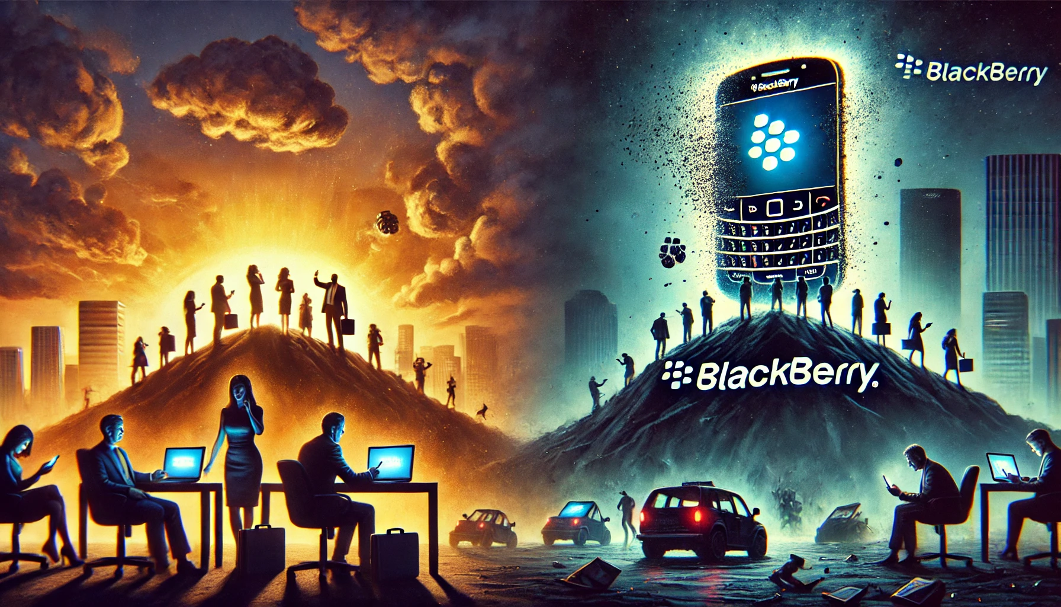The Rise, Reign, and Ruin of BlackBerry – A Masterclass in Why Innovation Alone is Not Enough 💗♾️
BlackBerry, once a dominant player in the mobile market, failed to adapt to the changing consumer landscape brought about by the iPhone.

THE FALL OF BLACKBERRY: THEY WEREN’T READY FOR THE iCONSUMER ZAPPER
When Steve Jobs unveiled the iPhone in 2007, BlackBerry’s leadership literally laughed.
🛑 They dismissed touchscreen keyboards as “impractical.”
🛑 They believed business users would never give up their physical keyboard.
🛑 They saw Apple as a company making “toys” - not serious business tools.
What BlackBerry failed to see was that consumer behavior was changing forever.
💡 The iPhone wasn’t about better email or security.
💡 It was about a completely new way to experience the internet and apps.
💡 It was about bonding with consumers - not just selling to business users.
By 2010, BlackBerry was still growing - but their consumer market was evaporating. Apple and Android had taken over.
🚀 BlackBerry was unstoppable. Until it wasn’t.
In the early 2000s, BlackBerry wasn’t just a phone - it was a status symbol, a power tool, a cultural phenomenon.
CEOs, celebrities, even world leaders couldn’t live without it.
But by 2016? The brand had vanished from relevance. A once-dominant market leader had collapsed into irrelevance.
💡 What happened? And more importantly… how can your business avoid the same fate?
The BlackBerry Era – What They Got Right
BlackBerry didn’t fail because it lacked innovation. In fact, it defined mobile communication before smartphones became mainstream.
🔹 It was first to market with secure mobile email.
🔹 It dominated business communication, creating a cult-like following.
🔹 Its iconic physical keyboard made it a productivity machine.
🔹 It created network effects - if you had a BlackBerry, your business contacts needed one too.
For a while, BlackBerry didn’t just have an edge - it was the market.
The iPhone Moment – What They Got Wrong
Then came 2007.
Steve Jobs stood on a stage and introduced the iPhone.
It wasn’t just a phone. It was a portal - a touchscreen-powered, app-driven, consumer-first revolution.
🔹 What did BlackBerry do? It dismissed the iPhone as a gimmick.
🔹 What did Apple do? It recognized that functionality wasn’t enough - emotional connection, ease of use, and a seamless experience-first approach were the real game-changers.
BlackBerry executives, stuck in their “rational” innovation mindset, refused to believe people would trade in a "professional" tool for a device with no keyboard.
💣 BIGGEST MISTAKE: BlackBerry assumed that tech specs and features were enough to keep people loyal. Apple understood that experience, emotion, and lifestyle bonds were the real differentiators.
The bonding game had begun. And BlackBerry wasn’t playing.
The Slow Motion Collapse – Where It All Fell Apart
After the iPhone launched, BlackBerry still had a chance to pivot. But instead of adapting, it…
🔹 Ignored consumer shifts – They kept focusing on security & enterprise while the world was moving toward personalization and connection.
🔹 Overlooked app ecosystems – They dismissed the App Store as a “toy,” failing to see that apps created entire new consumer habits.
🔹 Clung to past success – They doubled down on keyboards and corporate sales, while consumers embraced the touchscreen revolution.
🔹 Reacted too slowly – By the time they finally released touchscreen models, the market had already chosen Apple and Android.
💣 THE HARSH TRUTH: BlackBerry died not because it lacked innovation… but because it failed to evolve its bond with consumers.
The BlackBerry Lesson – Why Innovation Alone Won’t Save You
BlackBerry had the tech. It had the first-mover advantage. It had market dominance.
But it lost the consumer connection. And when that was gone, everything collapsed.
🔹 What does this teach us?
✅ Being first doesn’t matter if you don’t keep evolving.
✅ Logic-based innovation (better specs, better features) is not enough.
✅ Bonding with consumers - deeply understanding and evolving with their desires - is what keeps brands relevant.
BlackBerry built an empire on tech-driven innovation. But Apple built a bond-driven ecosystem. That’s why one thrived, and the other died.
ImagineerShip: The Playbook for Longevity
What happened to BlackBerry is happening to brands every single day.
They believe product innovation is enough. It isn’t.
🚀 The brands that survive are the ones that master ImagineerShip: 🔹 Sense their journey. (Anticipate what they’ll want before they do.)
🔹 Think their experience. (Create a seamless, intuitive, and connected ShopperVerse.)
🔹 Feel their bond. (Move beyond transactions - create emotional loyalty.)
BlackBerry could have adapted. It could have Imagineered its way into a new future. Instead, it stayed locked in an old playbook - while the world moved on.
💡 If your brand isn’t growing consumer bonds, you’re one disruption away from irrelevance.
The question is: Are you the next BlackBerry… or the next Apple?
👉 The answer lies in how you bond, not just how you build.
💗♾️ ImagineerShip: Bonding is the New Branding.

